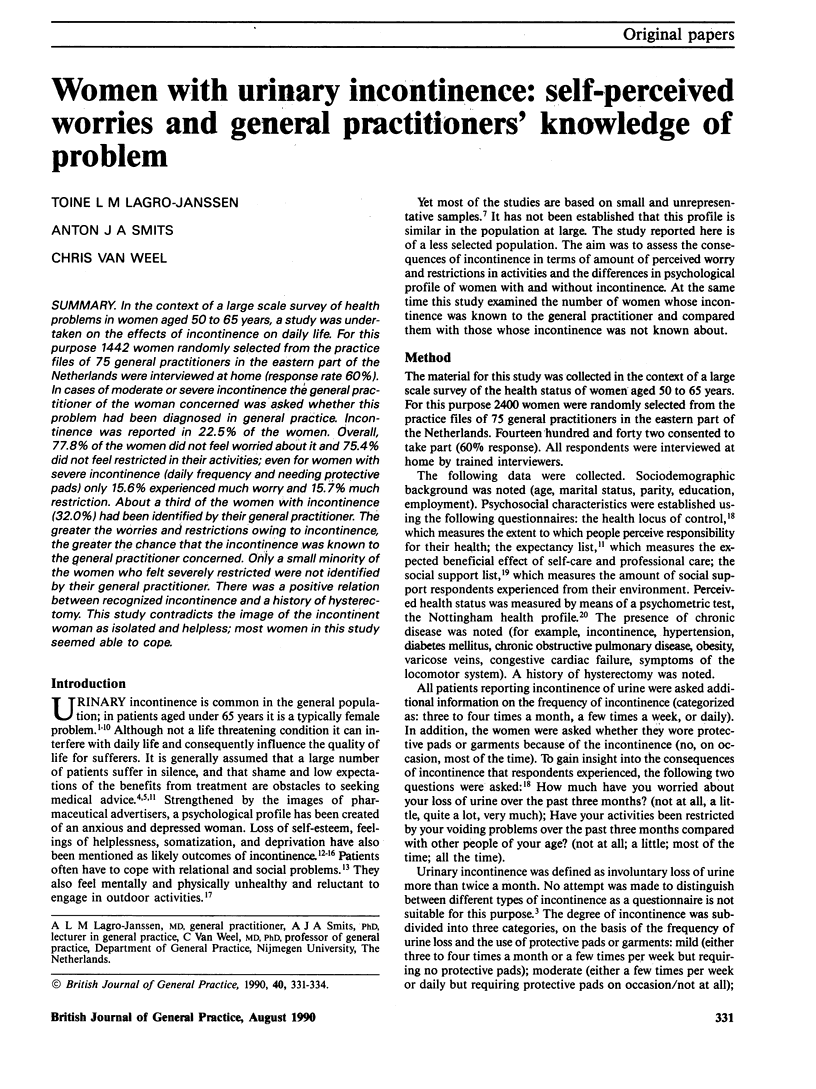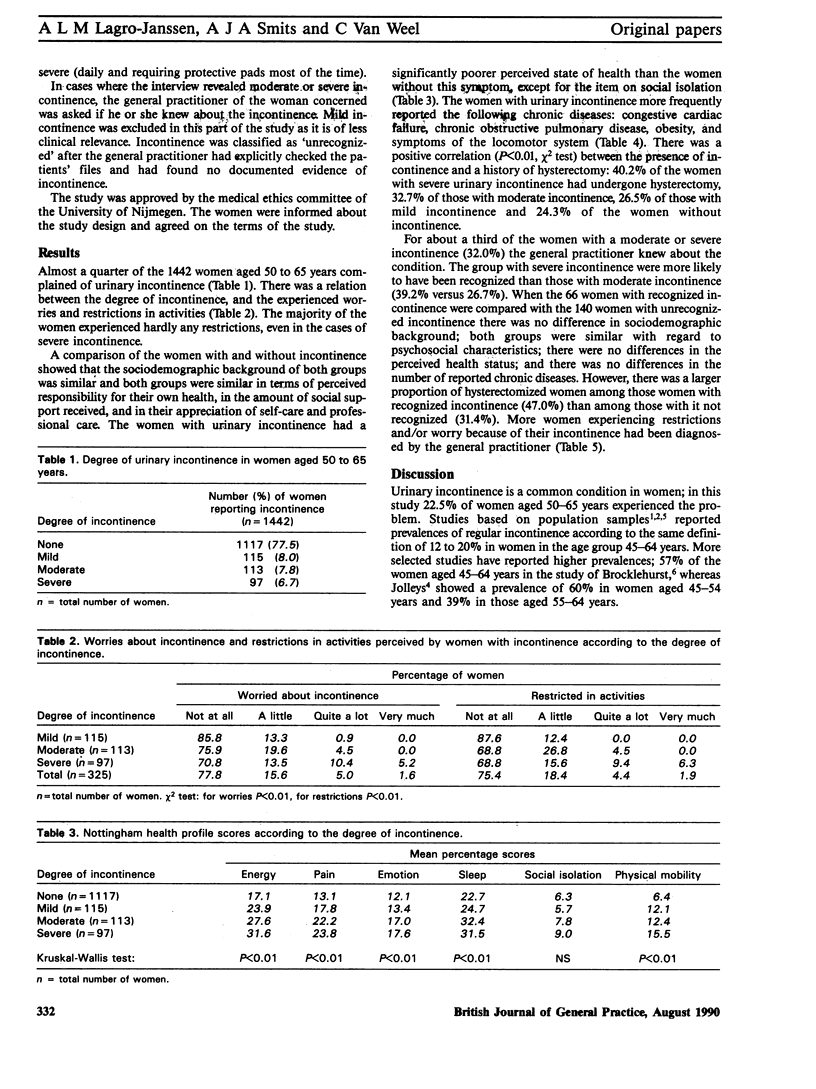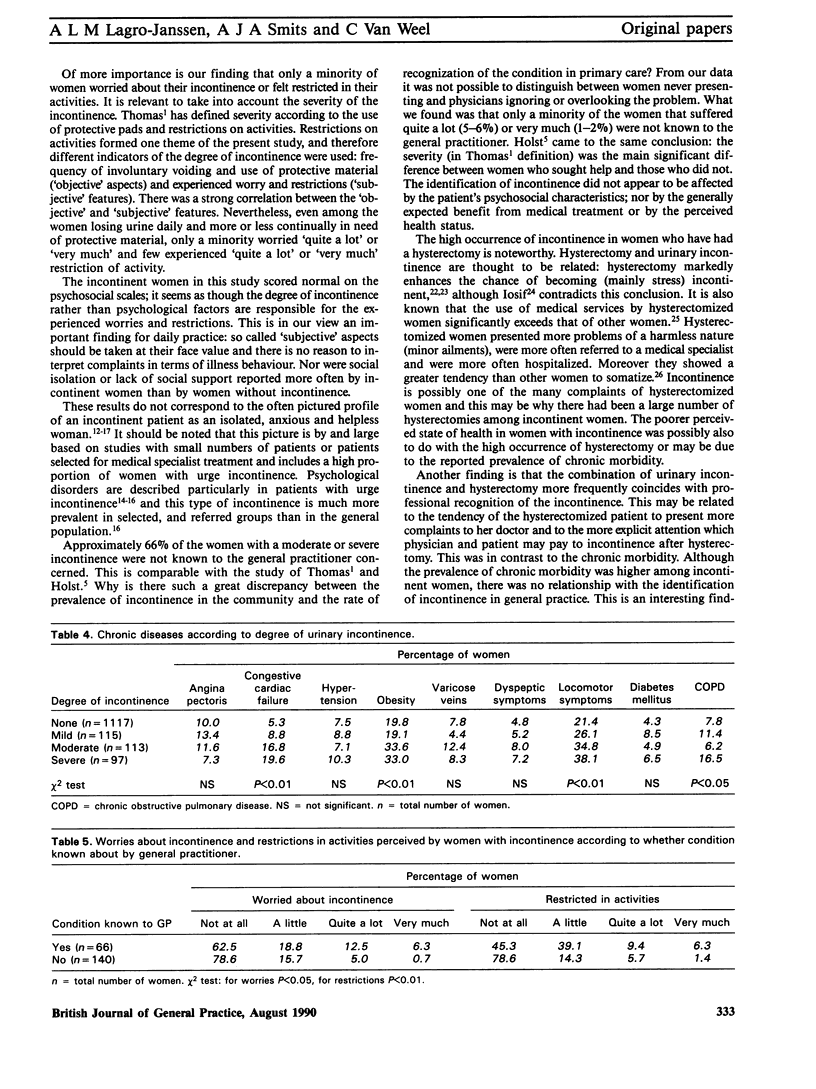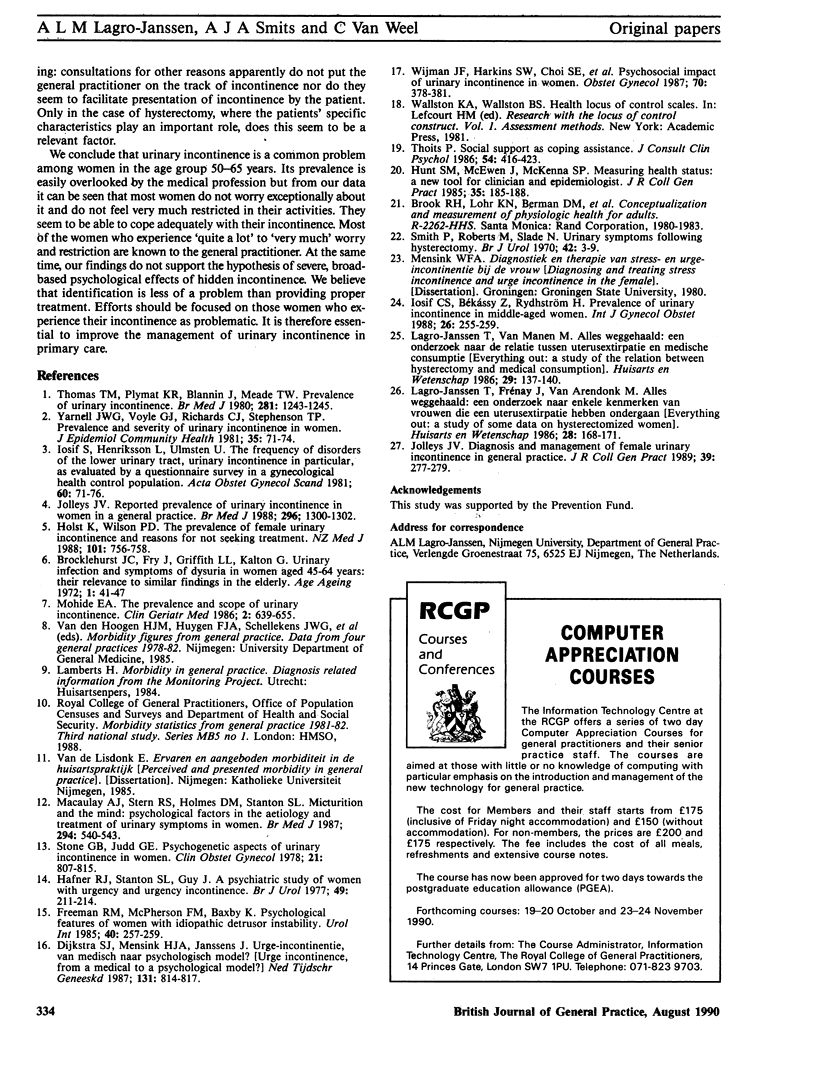Abstract
In the context of a large scale survey of health problems in women aged 50 to 65 years, a study was undertaken on the effects of incontinence on daily life. For this purpose 1442 women randomly selected from the practice files of 75 general practitioners in the eastern part of the Netherlands were interviewed at home (response rate 60%). In cases of moderate or severe incontinence the general practitioner of the woman concerned was asked whether this problem had been diagnosed in general practice. Incontinence was reported in 22.5% of the women. Overall, 77.8% of the women did not feel worried about it and 75.4% did not feel restricted in their activities; even for women with severe incontinence (daily frequency and needing protective pads) only 15.6% experienced much worry and 15.7% much restriction. About a third of the women with incontinence (32.0%) had been identified by their general practitioner. The greater the worries and restrictions owing to incontinence, the greater the chance that the incontinence was known to the general practitioner concerned. Only a small minority of the women who felt severely restricted were not identified by their general practitioner. There was a positive relation between recognized incontinence and a history of hysterectomy. This study contradicts the image of the incontinent woman as isolated and helpless; most women in this study seemed able to cope.
Full text
PDF



Selected References
These references are in PubMed. This may not be the complete list of references from this article.
- Dijkstra S. J., Mensink H. J., Janssens J. Urge-incontinentie, van medisch naar psychologisch model? Ned Tijdschr Geneeskd. 1987 May 9;131(19):814–817. [PubMed] [Google Scholar]
- Freeman R. M., McPherson F. M., Baxby K. Psychological features of women with idiopathic detrusor instability. Urol Int. 1985;40(5):257–259. doi: 10.1159/000281094. [DOI] [PubMed] [Google Scholar]
- Hafner R. J., Stanton S. L., Guy J. A psychiatric study of women with urgency and urgency incontinence. Br J Urol. 1977 Jun;49(3):211–214. doi: 10.1111/j.1464-410x.1977.tb04106.x. [DOI] [PubMed] [Google Scholar]
- Holst K., Wilson P. D. The prevalence of female urinary incontinence and reasons for not seeking treatment. N Z Med J. 1988 Nov 9;101(857):756–758. [PubMed] [Google Scholar]
- Hunt S. M., McEwen J., McKenna S. P. Measuring health status: a new tool for clinicians and epidemiologists. J R Coll Gen Pract. 1985 Apr;35(273):185–188. [PMC free article] [PubMed] [Google Scholar]
- Iosif C. S., Békássy Z., Rydhström H. Prevalence of urinary incontinence in middle-aged women. Int J Gynaecol Obstet. 1988 Apr;26(2):255–259. doi: 10.1016/0020-7292(88)90270-6. [DOI] [PubMed] [Google Scholar]
- Iosif S., Henriksson L., Ulmsten U. The frequency of disorders of the lower urinary tract, urinary incontinence in particular, as evaluated by a questionnaire survey in a gynecological health control population. Acta Obstet Gynecol Scand. 1981;60(1):71–76. doi: 10.3109/00016348109154113. [DOI] [PubMed] [Google Scholar]
- Jolleys J. V. Diagnosis and management of female urinary incontinence in general practice. J R Coll Gen Pract. 1989 Jul;39(324):277–279. [PMC free article] [PubMed] [Google Scholar]
- Jolleys J. V. Reported prevalence of urinary incontinence in women in a general practice. Br Med J (Clin Res Ed) 1988 May 7;296(6632):1300–1302. doi: 10.1136/bmj.296.6632.1300. [DOI] [PMC free article] [PubMed] [Google Scholar]
- Macaulay A. J., Stern R. S., Holmes D. M., Stanton S. L. Micturition and the mind: psychological factors in the aetiology and treatment of urinary symptoms in women. Br Med J (Clin Res Ed) 1987 Feb 28;294(6571):540–543. doi: 10.1136/bmj.294.6571.540. [DOI] [PMC free article] [PubMed] [Google Scholar]
- Mohide E. A. The prevalence and scope of urinary incontinence. Clin Geriatr Med. 1986 Nov;2(4):639–655. [PubMed] [Google Scholar]
- Stone C. B., Judd G. E. Psychogenic aspects of urinary incontinence in women. Clin Obstet Gynecol. 1978 Sep;21(3):807–815. doi: 10.1097/00003081-197809000-00016. [DOI] [PubMed] [Google Scholar]
- Thoits P. A. Social support as coping assistance. J Consult Clin Psychol. 1986 Aug;54(4):416–423. doi: 10.1037//0022-006x.54.4.416. [DOI] [PubMed] [Google Scholar]
- Thomas T. M., Plymat K. R., Blannin J., Meade T. W. Prevalence of urinary incontinence. Br Med J. 1980 Nov 8;281(6250):1243–1245. doi: 10.1136/bmj.281.6250.1243. [DOI] [PMC free article] [PubMed] [Google Scholar]
- Wyman J. F., Harkins S. W., Choi S. C., Taylor J. R., Fantl J. A. Psychosocial impact of urinary incontinence in women. Obstet Gynecol. 1987 Sep;70(3 Pt 1):378–381. [PubMed] [Google Scholar]
- Yarnell J. W., Voyle G. J., Richards C. J., Stephenson T. P. The prevalence and severity of urinary incontinence in women. J Epidemiol Community Health. 1981 Mar;35(1):71–74. doi: 10.1136/jech.35.1.71. [DOI] [PMC free article] [PubMed] [Google Scholar]


